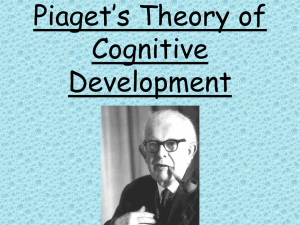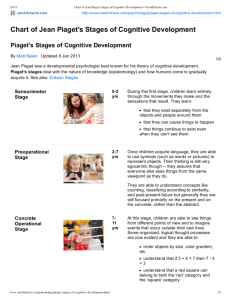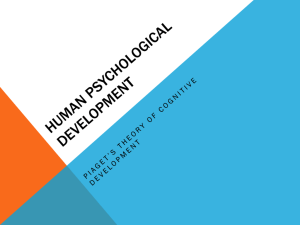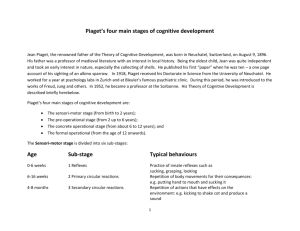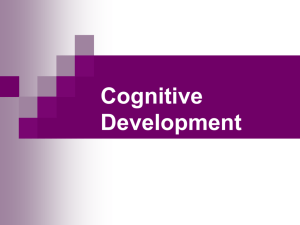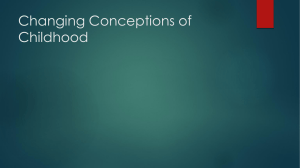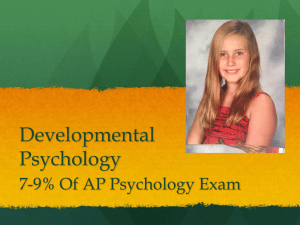here
advertisement
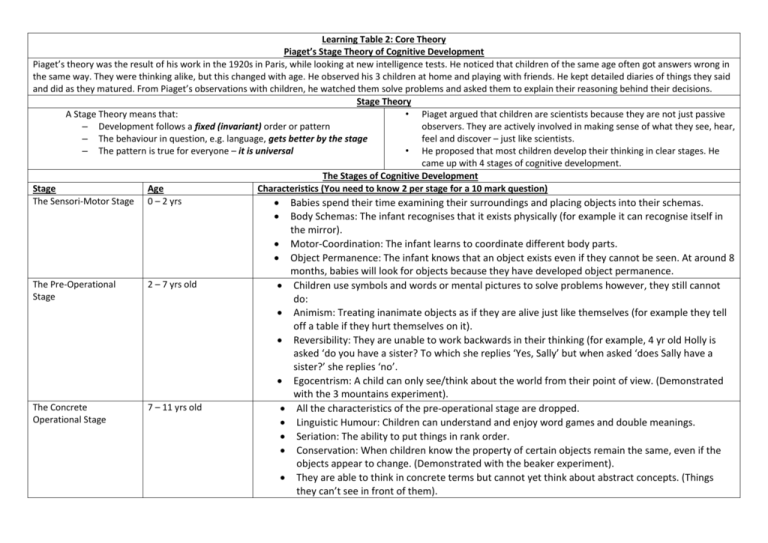
Learning Table 2: Core Theory Piaget’s Stage Theory of Cognitive Development Piaget’s theory was the result of his work in the 1920s in Paris, while looking at new intelligence tests. He noticed that children of the same age often got answers wrong in the same way. They were thinking alike, but this changed with age. He observed his 3 children at home and playing with friends. He kept detailed diaries of things they said and did as they matured. From Piaget’s observations with children, he watched them solve problems and asked them to explain their reasoning behind their decisions. Stage Theory A Stage Theory means that: • Piaget argued that children are scientists because they are not just passive – Development follows a fixed (invariant) order or pattern observers. They are actively involved in making sense of what they see, hear, – The behaviour in question, e.g. language, gets better by the stage feel and discover – just like scientists. – The pattern is true for everyone – it is universal • He proposed that most children develop their thinking in clear stages. He came up with 4 stages of cognitive development. The Stages of Cognitive Development Stage Age Characteristics (You need to know 2 per stage for a 10 mark question) The Sensori-Motor Stage 0 – 2 yrs Babies spend their time examining their surroundings and placing objects into their schemas. The Pre-Operational Stage 2 – 7 yrs old The Concrete Operational Stage 7 – 11 yrs old Body Schemas: The infant recognises that it exists physically (for example it can recognise itself in the mirror). Motor-Coordination: The infant learns to coordinate different body parts. Object Permanence: The infant knows that an object exists even if they cannot be seen. At around 8 months, babies will look for objects because they have developed object permanence. Children use symbols and words or mental pictures to solve problems however, they still cannot do: Animism: Treating inanimate objects as if they are alive just like themselves (for example they tell off a table if they hurt themselves on it). Reversibility: They are unable to work backwards in their thinking (for example, 4 yr old Holly is asked ‘do you have a sister? To which she replies ‘Yes, Sally’ but when asked ‘does Sally have a sister?’ she replies ‘no’. Egocentrism: A child can only see/think about the world from their point of view. (Demonstrated with the 3 mountains experiment). All the characteristics of the pre-operational stage are dropped. Linguistic Humour: Children can understand and enjoy word games and double meanings. Seriation: The ability to put things in rank order. Conservation: When children know the property of certain objects remain the same, even if the objects appear to change. (Demonstrated with the beaker experiment). They are able to think in concrete terms but cannot yet think about abstract concepts. (Things they can’t see in front of them). The Formal Operational Stage 11+ yrs They can think about and solve sophisticated adult problems. For example, a 15 year old can compare several theories about why dinosaurs disappeared (grown up thinking also known as hypothetical thinking). Hypothetical thinking allows people to see the bigger picture. They can develop a general principle they can apply to other situations.
